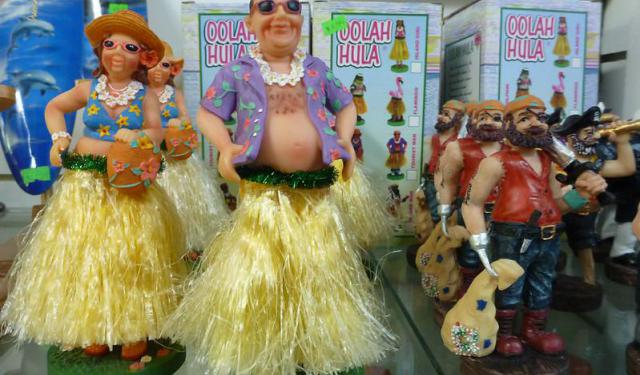
12 Distinctively Puerto Rican Goods to Bring Home from San Juan
The uniqueness of Puerto Rico is partially associated with its political status - part of the United States yet with a Latin twist. Other than their widely-acknowledged musical talents, e.g. Carlos Santana and Ricky Martin, Puerto Rico is just as rich in many other good things. When you're in San Juan, you will definitely appreciate the local food & drink, much as the colorful craftsmanship that abounds the city and can make a great souvenir to take home in long-lasting memory of this hospitable land!
(To visit the venues mentioned in this article, check out these Self-Guided Walking Tours in San Juan)
Image Courtesy of: Mstyslav Chernov
1. Cigars

The Spanish brought them back to Spain from Puerto Rico and called them “cigarillos.” Cigar making is still considered an art form in Puerto Rico. Until the late 1950s, Puerto Rico was among the world’s largest tobacco exporters, but the industry has since declined. There is a variety of Puerto Rican-made cigars, but one of the oldest and best-known brands from the island is Don Collins. Don Collins cigars are handmade in the oldest surviving cigar factory in the Caribbean. The factory itself dates back to 1506 and is available for tours. But you don’t have to go to the factory to take in the aroma of the famed tobacco; just walk into any one of the tobacco shops in San Juan or head straight to the Don Collins shop. Don Collins cigars use 13 different kinds of Puerto Rican-grown tobacco produced by independent farmers on the island. A Lonsdale bundle will run you about $140.00, while a bundle of Puros Indios costs $225.00. But if you want to try a few different ones, sample packs are available, ranging in price from about $40 to $70, depending on how many cigars are in the pack.
Price: $2-$17 per cigar.
Price: $2-$17 per cigar.
Where to find it:
Don Collins Cigarswww.don-collins.com
59 Calle Cristo
Old San Juan, PR
787 977-2983
Daily: 11am-7pm
Offline reading and travel directions:
With GPSmyCity App you can read this article offline on your mobile device, use the embedded offline city map and GPS navigation, as well as create a self-guided walk to visit the venues featured in the article.
2. Mundillo
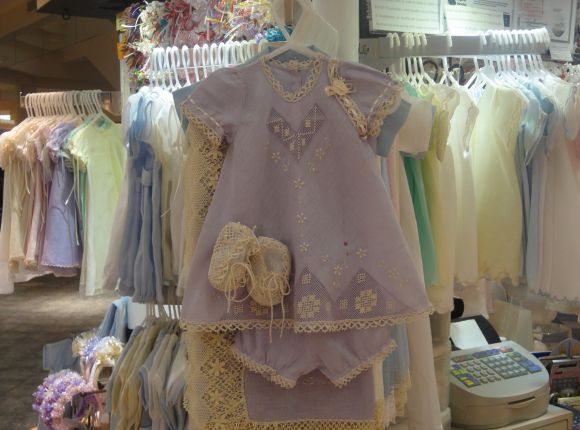
The art of bobbin lace making developed in Puerto Rico about two centuries ago, originally to adorn highly styled garments, such as the ones worn by the clergy. Today, this specialized lace continues to be used to decorate infant and toddler clothing. Almost every Puerto Rican baby, at some point, is dressed in a Mundillo lace ensemble. Mundillo is a special kind of knitting with multiple threads that produce intricate and artistic knits. The beautifully crafted Mundillo lace is made predominantly in the town of Moca, in the western part of the island, where most of the lace makers live and continue to teach the art. There is even a Museum of Mundillo in Moca and the town regularly hosts a Mundillo festival. Most of the clothing comes in pastel colors, like light yellow, lavender, turquoise, pink, as well as beige and white. This traditional Puerto Rican lace is also used to make table cloths, bedspreads and handkerchiefs.
The lace makers bring their carefully crafted infant jumpsuits, dresses, headbands, booties, blankets and bonnets to sell in San Juan, usually at artisan festivals.
Prices: range from $50 for a simple infant outfit to $500 for a highly styled blanket.
The lace makers bring their carefully crafted infant jumpsuits, dresses, headbands, booties, blankets and bonnets to sell in San Juan, usually at artisan festivals.
Prices: range from $50 for a simple infant outfit to $500 for a highly styled blanket.
Where to find it:
Mi Pequeno Angelito500 Avenue de Diego
San Juan, PR
787 977-0363
Monday - Saturday: 11 am - 4 pm
Offline reading and travel directions:
With GPSmyCity App you can read this article offline on your mobile device, use the embedded offline city map and GPS navigation, as well as create a self-guided walk to visit the venues featured in the article.
3. Ceramics
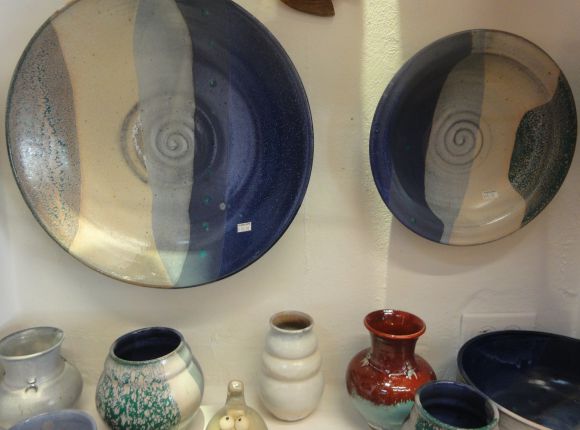
Art is everywhere in San Juan and art and crafts shops can be found throughout the narrow, winding cobblestone streets of the old city. Many of the artists have been schooled at one of the local art institutes, while some are simply self-taught. Ceramics are one specialty that you will see in many different shops and galleries, but at Puerto Rico Art & Crafts artisans have a unique opportunity to show off their creations. The store allows artists to have their own shelf or wall to display their work. The ceramics really stand out here with larger items, like colorful plates and bowls, to smaller objects, such as cups and vases. The shop is located in a restored Spanish colonial building in the heart of Old San Juan, and artists from all over the island are featured here at different times during the year.
Prices: $6-$900.
Prices: $6-$900.
Where to find it:
Puerto Rican Art & Craftswww.puertoricanart-crafts.com
204 Fortaleza Street
Old San Juan, PR
787 725-5596
Monday-Saturday: 10am-6pm
Sunday: Noon-5pm
Buy It on Amazon:
Offline reading and travel directions:
With GPSmyCity App you can read this article offline on your mobile device, use the embedded offline city map and GPS navigation, as well as create a self-guided walk to visit the venues featured in the article.
4. Pilon

Mashed plantains is one of the most popular dishes in Puerto Rico. Almost every creole restaurant on the island features some kind of mashed plantains or “mofongo” stuffed with different sorts of meat and seasonings. However, in order to make this traditional dish, you need a pilon that is used to smash the fried unripe green plantains. Pilon is a Puerto Rican wooden mortar and pestle which can also be used to crush spices. At one time, it was even used to grind coffee. Some pilones are made from the wood of Guayacan trees and can be decorative as much as useful. It is said that the Taino Indians used large hollowed out tree trunks to make their waist high pilones. Today, you can find pilones of different sizes, small - to grind up spices, as well as bigger ones.
You will see pilones sold at a number of shops in San Juan, but some of the most interesting ones can be found at San Juan’s highly popular shopping mall, Plaza Las Americas. On the 3rd floor of the mall, there is a special gallery that features crafts of the local artisans seeking to sell their work to a wider clientele. There, you will find many of the local crafts, as well as some of the most beautiful wooden pilones.
Price: $25-$300.
You will see pilones sold at a number of shops in San Juan, but some of the most interesting ones can be found at San Juan’s highly popular shopping mall, Plaza Las Americas. On the 3rd floor of the mall, there is a special gallery that features crafts of the local artisans seeking to sell their work to a wider clientele. There, you will find many of the local crafts, as well as some of the most beautiful wooden pilones.
Price: $25-$300.
5. Bags
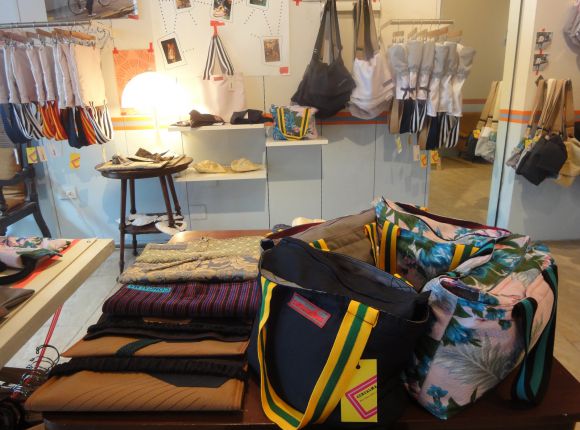
Climbing up and down some of the hills of Old San Juan can really tire you out, especially if you’re carrying a heavy bag or backpack. A local bag designer has made a splash with her lightweight and fashionable cotton bags that can be worn cross body, over the shoulder or even around your waste, but have room for all of the essentials. These bags are also convenient if you’re riding a bike, because of their lightness. The store’s owner and designer sacrifices nothing in style while insisting upon the bags practicality. The exterior is made out of cotton, but lined with nylon. The different fabrics all come from Puerto Rican suppliers and there are always 15 different designs in the store on any given day. You can choose from totes, clutches or messenger style bags, all in a variety of color combinations. The bags are utilitarian, yet trendy, and are all manufactured in a co-op in Puerto Rico’s beautiful mountain town of Utuado; they are only sold in San Juan.
Price: $40-$75.
Price: $40-$75.
6. Vejigantes

These colorful decorative masks represent 11th century Spanish Moors and are often seen during Carnival or the St. James Festival in Puerto Rico, which takes place in July. These brilliant clown-like masks have protruding horns, oversize lips, noses and eyes, and are often worn with equally colorful costumes. The masks date back to the 1700s' Spanish traditions and represent a spiritual battle between Apostle James and Spanish Muslims. The masks can be quite scary. They represent “evil” in the fight between good and evil that often is the theme at carnivals around the world. The Vejigante masks of Puerto Rico come from two towns of historic importance.
Loiza is a small town whose population was once made up of freed or escaped African slaves. The masks in Loiza are made from coconut shells and have a strong African influence in their tradition and design. In Ponce, Puerto Rico’s second largest city, the masks are made of paper-mache. The art of mask-making comes from both Spanish and African culture and has been passed down from generation to generation. These decorative masks can be found in different colors and sizes and hang nicely on a wall.
Price: $18-$150.
Loiza is a small town whose population was once made up of freed or escaped African slaves. The masks in Loiza are made from coconut shells and have a strong African influence in their tradition and design. In Ponce, Puerto Rico’s second largest city, the masks are made of paper-mache. The art of mask-making comes from both Spanish and African culture and has been passed down from generation to generation. These decorative masks can be found in different colors and sizes and hang nicely on a wall.
Price: $18-$150.
Where to find it:
El Galpon154 Calle del Cristo
San Juan, PR
787-725-3945
Daily: 10am - 6 pm
7. Wood Carvings of Saints

The festival of the Three Kings is probably more celebrated in Puerto Rico than even Christmas. In almost every crafts store in San Juan you will find shelves of wood-carved saints or “santos” in all sizes and styles, most often representative of the Three Kings. Historically, these wood images of saints were used as objects for prayer. Today, the saints represent an important part of Puerto Rican culture. When the Spanish arrived on the island in the late 1400s, these representations of saints were used to help in efforts to convert to Catholicism the indigenous people of the island – first, the Taino Indians and, later, slaves from Western Africa. Saint carvings eventually evolved to become more a part of the art culture leaving behind much of the religious attachments. These statuettes can be simple or ornately painted and can be hung on the wall or stand on their own.
You will find these wood carvings of saints at many shops throughout San Juan, but El Galpon, located in a little alley right off one of the main shopping streets, has a special collection displayed along the wall, and the shop’s owner will tell you about the history of the saints and their origins.
Price: $45-$1,000.00.
You will find these wood carvings of saints at many shops throughout San Juan, but El Galpon, located in a little alley right off one of the main shopping streets, has a special collection displayed along the wall, and the shop’s owner will tell you about the history of the saints and their origins.
Price: $45-$1,000.00.
Where to find it:
El Galponwww.elgalpon.net
154 Calle Cristo
Old San Juan, PR
787 725-3945
Daily: 10am-6pm
8. Spices
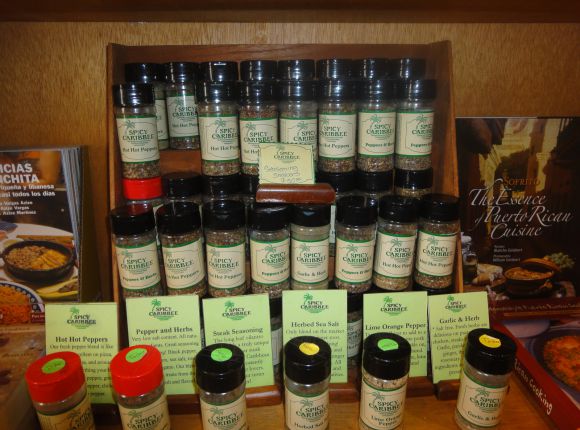
Puerto Rican cooking often involves cilantro, a lime sort of flavor that can be found in a lot of different Latin American cooking practices. But even more popular than cilantro in Puerto Rico, is recao, a more aromatic, jagged edged long leaf kind of cilantro. Some of the other favorite flavors on the island include orange, lime, mango and a variety of peppers, depending on what’s in season.
If you want to taste some of the different seasonings of Puerto Rican cooking, stop by Spicy Caribbee, a quaint little shop, located in one of Old San Juan’s precious alleyways, which offers tastings of their spices, jams and sauces. All the seasonings here have been inspired by the owner’s travels throughout the Caribbean and her wish to create Puerto Rico’s best herb combinations. The spices come in attractive gift-size jars and bottles that are easily packed. The owner of the shop, Nereida Williams, created the spice recipes herself and they are almost all made with local ingredients. Some of the biggest sellers are the “Herbed Sea Salt,” an all-around seasoning that is great with pork, chicken or fish, the “Steak Seasoning” made with the local recao leaf, and the “Lime, Orange, Pepper” which is salt-free. So, if you want to bring home a little taste of Puerto Rico, you can pick up a jar or two and savor the flavors of the island long after your trip.
Price: $5-$10 per jar.
If you want to taste some of the different seasonings of Puerto Rican cooking, stop by Spicy Caribbee, a quaint little shop, located in one of Old San Juan’s precious alleyways, which offers tastings of their spices, jams and sauces. All the seasonings here have been inspired by the owner’s travels throughout the Caribbean and her wish to create Puerto Rico’s best herb combinations. The spices come in attractive gift-size jars and bottles that are easily packed. The owner of the shop, Nereida Williams, created the spice recipes herself and they are almost all made with local ingredients. Some of the biggest sellers are the “Herbed Sea Salt,” an all-around seasoning that is great with pork, chicken or fish, the “Steak Seasoning” made with the local recao leaf, and the “Lime, Orange, Pepper” which is salt-free. So, if you want to bring home a little taste of Puerto Rico, you can pick up a jar or two and savor the flavors of the island long after your trip.
Price: $5-$10 per jar.
Where to find it:
Spicy Caribbeewww.spicycaribbee.com
154 Calle Cristo
Old San Juan, PR
888 725-7259
Monday-Sunday: 10am-6pm
9. Rums
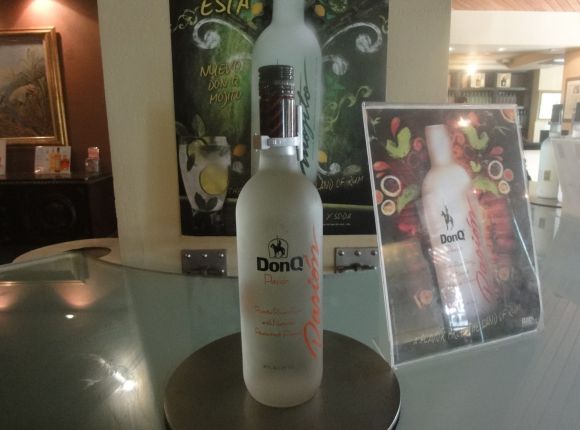
Though other Caribbean islands produce a variety of rums of their own, over 70% of rum sales in the United States come from Puerto Rico. The process of rum making begins with crushing sugar cane; eventually, the produced spirit is aged in oak barrels and then blended to get just the right taste for each variety.
Price: $15-$55.
Price: $15-$55.
10. Guiro

Music is definitely a key part of Puerto Rican culture and the island is known for several musical instruments and their unique sounds. Today, Puerto Rico is often associated with its popular reggaeton, as well as salsa. But the island’s more traditional music includes Bomba, Plena and Danza, all very distinct musical styles that have evolved to some degree, but have long histories. Bomba and Plena come from West African musical traditions, and often tell a certain story through words and music. One of the instruments you will most likely find accompanying Bomba or a Plena, or any other Puerto Rican folk music for that matter, is Guiro.
A Guiro is believed to have originated with the indigenous Taino Indians. This percussion instrument is made from a hollowed-out gourd with parallel grooves carved into its surface and it makes a rasping sound when stroked up and down with a scraper. The straighter and more consistent are the grooves of the Guiro, the better is the quality of the instrument. The Guiro is often played by a singer and comes in a variety of sizes.
Price: $8-$16.
A Guiro is believed to have originated with the indigenous Taino Indians. This percussion instrument is made from a hollowed-out gourd with parallel grooves carved into its surface and it makes a rasping sound when stroked up and down with a scraper. The straighter and more consistent are the grooves of the Guiro, the better is the quality of the instrument. The Guiro is often played by a singer and comes in a variety of sizes.
Price: $8-$16.
11. Hammocks
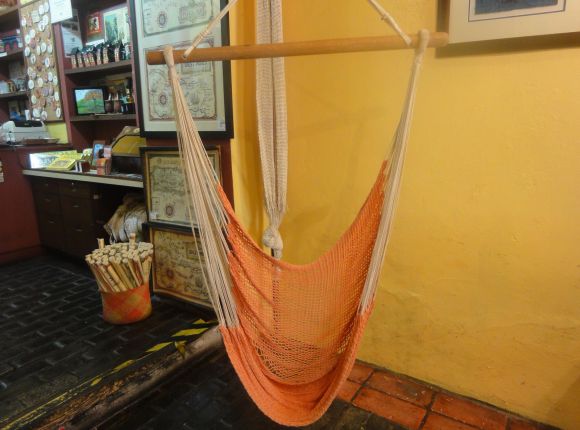
Hammock weaving has long been a specialty in the Puerto Rican town of San Sebastian, located in the northwest corner of the island. The town even hosts a hammock festival in July. Legend has it that hammock weaving, just like so many other crafts in Puerto Rico, has been handed down from the Taino Indians. Even the word “hammock” has most likely derived from the Taino word “hamaca” meaning a comfortable lounging chair. While most hammocks are designed and made in small towns across the island by individual craftspeople, you can find these authentic and durable hammocks being sold in a handful of places in the city of San Juan. The hammocks are made from cotton and cord and are sometimes dyed in bright colors. They come in a variety of sizes, like a chair for one person, or a double chair for two. Some hammocks can even hold up to 450 pounds.
Price: $50-$200.
Price: $50-$200.
Where to find it:
La Calle Shopping Mall105 Fortaleza Street
Old San Juan, PR
787 725-1306
Tuesday - Sunday: 10am-8pm
12. Coffee

In San Juan, ordering a cup of coffee or a “cafecito” is a part of just about everyone’s daily life. People gather at almost any hour at one of the old city’s outdoor plazas to sip some coffee and engage in lively conversations with friends. Coffee was once one of Puerto Rico’s top exports until a decline in production forced most of the smaller coffee plantations to close. Recently, there has been a resurgence of small family farms coffee production and a handful of micro-roasteries and coffeehouses have opened, serving single-origin coffee grown in the island’s interior mountains.
One of the newest to open in San Juan’s historic old city is Cuatro Sombras – which means Four Shades (or shadows) and refers to the four different trees that provide shade to their coffee beans while they grow. The Santa Clara coffee farm had its doors closed, just like many others in Puerto Rico, back in the mid 1950s. Fortunately, these days, the descendants of the original family decided to dedicate themselves to reviving the farm. As a result, Cuatro Sombras, certified for making specialty coffee, now offers their crisp, clean tasting coffee to local coffee lovers and visitors alike. An 8-ounce latte costs $2.09.
Price: 8 oz. bag of coffee beans is $11.77, including tax.
One of the newest to open in San Juan’s historic old city is Cuatro Sombras – which means Four Shades (or shadows) and refers to the four different trees that provide shade to their coffee beans while they grow. The Santa Clara coffee farm had its doors closed, just like many others in Puerto Rico, back in the mid 1950s. Fortunately, these days, the descendants of the original family decided to dedicate themselves to reviving the farm. As a result, Cuatro Sombras, certified for making specialty coffee, now offers their crisp, clean tasting coffee to local coffee lovers and visitors alike. An 8-ounce latte costs $2.09.
Price: 8 oz. bag of coffee beans is $11.77, including tax.
Other Interesting Souvenirs from Puerto Rico
If traveling to Puerto Rico is not on your immediate agenda, or you simply can't afford an extra space in your luggage, fortunately, these days, you can find a wide selection of authentic and truly interesting Puerto Rican souvenirs online. Presented here are some of the Puerto Rican products sought by foreign visitors, now available online for your convenience.
1. Puerto Rican Traditional Snacks - Crunchy and tasty beef & cheese turnovers (empanadillas de carne), cakes, sorullos, arepas, tacos and alcapurrias make up the variety of foods fit to satisfy your taste buds with Puerto Rican flavor, as they are stuffed with it from tip to tip. You can also indulge your sweet tooth with the tropical taste of Puerto Rico, even if you are thousands of miles away, treating it to some Puerto Rican lollipops or dried fruits. The taste Puerto Rico really loves!
2. Caribbean Handmade Soap - Handmade in Puerto Rico, this Caribbean soap reveals what the tropics are all about. Other than the sweet scent, the soap gently exfoliates the skin and is renowned for its moisturizing and detoxifying properties thanks to the presence of fresh coconut milk & coconut meat, oatmeal flakes, vanilla & goat's milk, as well as Dead Sea mud.
Get GPSmyCity App for IOS or Android
You can read offline thousands of travel articles like this one in the "GPSmyCity: Walks in 1K+ Cities" app on Apple App Store or Google Play Store. The apps also offer city offline maps and GPS navigation to guide you to the places featured in the articles.
Walking Tours in San Juan, Puerto Rico
Create Your Own Walk in San Juan
Creating your own self-guided walk in San Juan is easy and fun. Choose the city attractions that you want to see and a walk route map will be created just for you. You can even set your hotel as the start point of the walk.
Souvenir Shopping
The arrival of Christopher Columbus in 1493 and the ensuing Spanish colonization brought into Puerto Rico a number of new crafts. Over the next few centuries, having mixed up with local traditions, they have flourished on the new turf, producing an array of colorful products that today are sought after by tourists visiting the island. While in San Juan, it would be a pity to leave town without... view more
Tour Duration: 1 Hour(s)
Travel Distance: 0.6 Km or 0.4 Miles
Tour Duration: 1 Hour(s)
Travel Distance: 0.6 Km or 0.4 Miles
Old San Juan Squares
A distinctive feature of Old San Juan is the multitude of quaint picturesque squares, many of them adorned with beautiful fountains and spectacular monuments. Each square has a unique character and historical significance, making them integral to the city's identity.
Plaza Colon, also known as Columbus Square, pays homage to Christopher Columbus and his exploration of the New World. It... view more
Tour Duration: 1 Hour(s)
Travel Distance: 1.8 Km or 1.1 Miles
Plaza Colon, also known as Columbus Square, pays homage to Christopher Columbus and his exploration of the New World. It... view more
Tour Duration: 1 Hour(s)
Travel Distance: 1.8 Km or 1.1 Miles
San Juan Historical Buildings
One of the oldest capital cities on the American continent, San Juan, Puerto Rico, boasts an old town that is filled to the brim with heritage colonial architecture.
Chief among its historical buildings, La Fortaleza, or The Fortress, is the official residence of the Governor of Puerto Rico and the longest-standing executive mansion in continuous use in America. At the same time, the Cathedral... view more
Tour Duration: 2 Hour(s)
Travel Distance: 2.4 Km or 1.5 Miles
Chief among its historical buildings, La Fortaleza, or The Fortress, is the official residence of the Governor of Puerto Rico and the longest-standing executive mansion in continuous use in America. At the same time, the Cathedral... view more
Tour Duration: 2 Hour(s)
Travel Distance: 2.4 Km or 1.5 Miles












